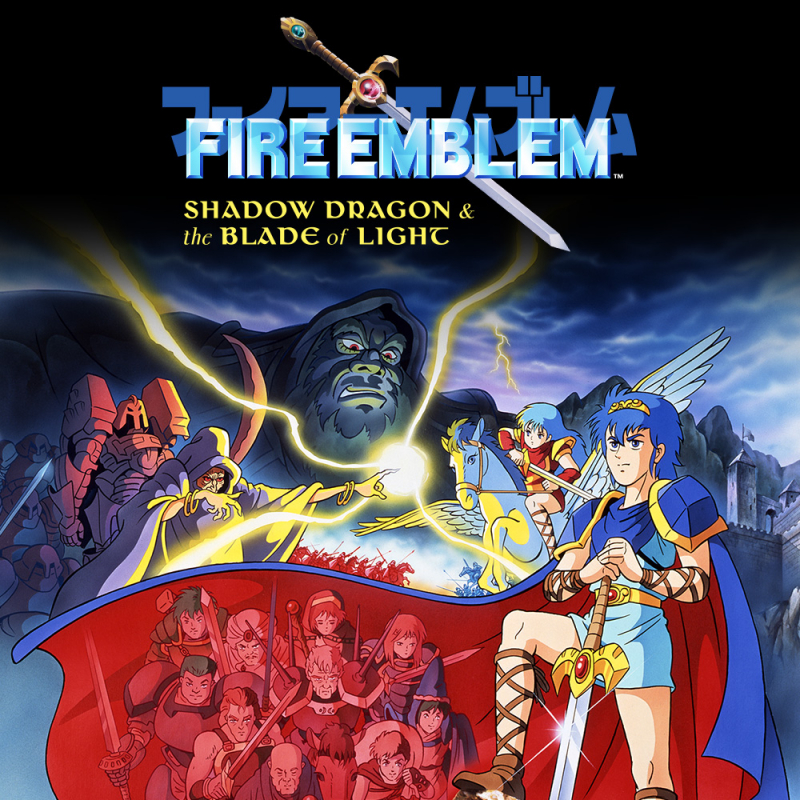
Fire Emblem: Shadow Dragon and the Blade of Light (NS) - Review
by Paul Broussard , posted on 22 January 2021 / 6,051 ViewsThe original Fire Emblem (not to be confused with the similarly titled “Fire Emblem” in the West) is a game that’s become somewhat buried and forgotten over the years. Despite receiving several remakes and reimaginings, the original title tends to be often ignored in favor of other games in the series, such as Blazing Blade, Path of Radiance, and Awakening. This is particularly true for the West, where the original title never launched. Now, however, Nintendo has finally released a fully localized version of the original Fire Emblem on the Switch. Will it bring Marth’s adventure back into the spotlight for good, or is this just a fleeting moment of glory?

Fire Emblem, also known as Shadow Dragon and the Blade of Light, focuses on the story of Marth, prince of the fictional country of Altea. After his homeland is invaded and his father is killed, a young Marth is forced to flee to the adjacent country of Talys. There, he slowly begins to build allies and embarks on a quest to reclaim his homeland and foil the plans of the main antagonist, Gharnef. And since this is Fire Emblem, you can expect to encounter an ever growing entourage of characters, at least one dragon going senile, and a mentor figure who starts off overpowered but winds up useless.

Since this is a game from 1990, the story remains simplistic and straightforward. You won’t find any support conversations, and dialogue between characters is relatively minimal. The dialogue is also a little janky; I’m not quite certain if this is a result of the translation not receiving full attention or if it’s just an accurate representation of some of the broken writing common to older video games, but you may find yourself having to double take on the text a few times.
Not much has been done to change the base experience of the original title, so if you’re used to newer Fire Emblems you may find yourself taken aback, to the point where playing Shadow Dragon and the Blade of Light can be a struggle. While I can appreciate the desire to preserve the original, some addendums probably would’ve helped the experience feel a bit less outdated. Certain modern inclusions, like more extensive supports, pair up mechanics, and customizable classes are all absent, which is fine, but the most basic components of strategy games are left out to preserve the original title. Even something as basic as seeing your percent chance to hit is missing, and adding that in as an optional feature wouldn’t have hurt the purist hope for the game.

That said, there are a few changes. Perhaps the most significant is that the game now allows for you to place a bookmark at any point and revert back if something goes wrong, which admittedly does rather break the strategy aspect in two if you choose to use it. Fortunately, it’s entirely optional, and obtaining victory without it is certainly doable. The other major change is that the speed of the game is now adjustable, which is a huge improvement, as the original title would absolutely crawl through enemy phases, making redoing maps an absolute chore. These two elements make this title a bit more approachable for a casual audience, so if you’re looking to experience where Fire Emblem started without straining, this may do it for you.
The rest of Shadow Dragon and the Blade of Light plays out pretty much exactly like the original game in 1990 did. At the outset of each chapter, the player is presented with a grid-like map to move units around, and given a point on the map that needs to be captured in order to clear it. Of course, it’s not that simple, as enemy units block the way, requiring the player to attack them in turn-based, strategic combat. For the most part, there's no way to raise unit levels outside of normally engaging with enemies, meaning that it's often in the player’s best interest to fight as many enemies as possible in order to obtain maximum experience.

The real meat of the gameplay revolves around the various types of units. Differing units, of course, have differing qualities, making it important to consider which unit is positioned to fight which enemy. Placing an armored soldier with low resistance in range of a mage is a bad idea, as is leaving your own mages in range of enemies with high physical attack.
This is all bread and butter Fire Emblem, which is, at the end of the day, exactly what this game is. There’s obviously a limit to how much the original game in a series can be criticized for a lack of innovation, and I certainly won’t say that Nintendo should have remade this game (again) when it was clearly intended to be a re-release with a few minor touch ups, but the fact of the matter is that, if you’re planning to buy this game, you should do so knowing how simplistic it is. There's very little depth to Shadow Dragon and the Blade of Light, and if you’re familiar with strategy games at all you’ll likely be a little disappointed if you come into this expecting anything other than an SRPG at its most basic.

But if you’re looking to experience Fire Emblem at its simplest, Shadow Dragon and the Blade of Light will certainly accomplish that. Nintendo has by and large preserved the original title, added in a few nice quality of life improvements, and made it pretty cheap. If you want to check out where everything started, this is a decent trip down memory lane.
This review is based on a digital copy of Fire Emblem: Shadow Dragon and the Blade of Light for the NS
More Articles
I started playing Awakening a few days ago and I'm in a Fire Emblem fever that makes me consider buying Shadow Dragon and the Blade of Light. Apparently it is a more nostalgic experience than a good one in itself. Well, I have until March 31 to decide if I risk purchasing the first game in the series...
I think I'll get it, it's only 6 bucks so I figure I'd give it a shot.
























 Essay Pro
Essay Pro